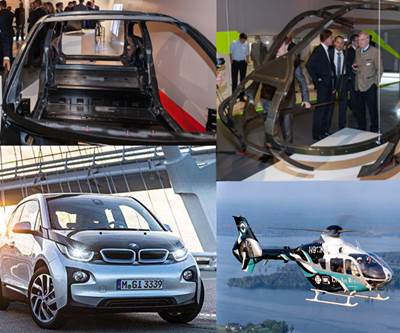Lilium celebrates maiden flight of CFRP air taxi
All-electric jet-powered, 5-seater uses composites to deliver performance.
Lilium (Munich, Germany) today revealed its new all-electric, five-seater air taxi prototype, the Lilium Jet, which completed its maiden flight in the skies over Germany earlier this month.
The structure of the Lilium Jet is nearly all carbon fiber-reinforced polymer (CFRP), the company says, a key component of the ultra-lightweight design. The full-scale, full-weight prototype is powered by 36 all-electric jet engines that reportedly enable it to take off and land vertically, while achieving efficient horizontal, or cruise, flight. The simple aircraft design — no tail, no rudder, no propellers, no gearbox and only one moving part in the engine — is said to contribute to the safety and affordability of the aircraft while also enabling the team to add aesthetic elements such as panoramic windows and gull-wing doors.
The aircraft reportedly can achieve a maximum speed of 300 kmh and a range of 300 kilometers. Its endurance is said to be due in part to an efficient, fixed wing design that generates enough lift to keep it in the air during cruise flight while using less than 10% of the aircraft’s 2000 horsepower. The aircraft is said to be an affordable, high-speed commuter option for connecting suburbs to city centers, airports to main train stations and travel between regions.
“Today we are taking another huge step towards making urban air mobility a reality,” says Daniel Wiegand, co-founder and CEO. “In less than two years, we have been able to design, build and successfully fly an aircraft that will serve as our template for mass production.”
The Lilium Jet’s first flight took place on May 4, after ground testing at the company’s headquarters in Munich, Germany. The prototype aircraft, which is controlled remotely from the ground, has since begun a flight test campaign to prove its capability and lay the foundations for certification of the aircraft to safety standards comparable to those of large commercial aircraft.
“Moving from two to five seats was always our ambition as it enables us to open up the skies to many more travelers,” Wiegand adds. “Whether it’s friends or families flying together or business travelers ride-sharing into the city, having five seats delivers an economy of scale you just can’t achieve with two. The Lilium Jet itself is beautiful and we were thrilled to see it take to the skies for the first time. With the perfect balance of range and speed, our aircraft has the potential to positively impact the way people choose to live and travel, all over the world.”
Lilium plans to manufacture and operate the Lilium Jet as part of its on-demand air taxi service. Lilium says carbon fiber composites have been in mind from the beginning and it is now planning for large-scale industrialization of its manufacturing processes. Passengers will be able to use the Lilium app to locate their nearest landing pad and plan their journey, and a network of taxi pads will be available across cities and regions. The aircraft is said to be comparable in price to a taxi but is four times faster.
Lilium expects to be fully-operational in various cities around the world by 2025, although trial services will start earlier than this in several locations.
The latest five-seater taxi builds on the successful flight testing of a two-seater prototype in 2017. The two-seater prototype provided proof of concept for Lilium’s signature transition flight maneuver, where the aircraft shifts from vertical to horizontal flight, and laid the groundwork for today’s prototype.
See the Lilium Jet in action and learn more in this video.
Related Content
The potential for thermoplastic composite nacelles
Collins Aerospace draws on global team, decades of experience to demonstrate large, curved AFP and welded structures for the next generation of aircraft.
Read MorePlant tour: Albany Engineered Composites, Rochester, N.H., U.S.
Efficient, high-quality, well-controlled composites manufacturing at volume is the mantra for this 3D weaving specialist.
Read MorePlant tour: Middle River Aerostructure Systems, Baltimore, Md., U.S.
The historic Martin Aircraft factory is advancing digitized automation for more sustainable production of composite aerostructures.
Read MoreA new era for ceramic matrix composites
CMC is expanding, with new fiber production in Europe, faster processes and higher temperature materials enabling applications for industry, hypersonics and New Space.
Read MoreRead Next
Carbon fiber will enable air taxi eVTOLs
Aircraft and autos have indeed faced CFRP production woes, but new tech opens door for both.
Read MorePlant tour: Daher Shap’in TechCenter and composites production plant, Saint-Aignan-de-Grandlieu, France
Co-located R&D and production advance OOA thermosets, thermoplastics, welding, recycling and digital technologies for faster processing and certification of lighter, more sustainable composites.
Read MoreVIDEO: High-volume processing for fiberglass components
Cannon Ergos, a company specializing in high-ton presses and equipment for composites fabrication and plastics processing, displayed automotive and industrial components at CAMX 2024.
Read More
.jpg;width=70;height=70;mode=crop)
.jpg;width=700;quality=80)
.jpg;width=860)














.jpg;maxWidth=300;quality=90)







